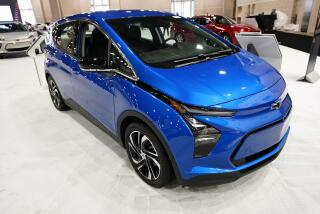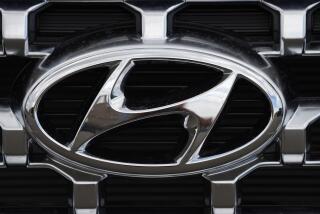The Cars Donât Leak, but the Rankings Do
On the day the data descended, Bill Baker was doing precisely what one would expect of a polished spokesman for regal vehicles: escorting her royal highness Princess Alexandria, first cousin of Queen Elizabeth, at the dedication of Land Rover North Americaâs new Maryland headquarters.
On the other side of the continent, J.D. Power & Associates announced its survey of the quality of 1997 domestic and imported cars and trucks.
And Land Rover, 50-year-old monarch of sport utilities, holder of as many royal warrants as Harrods, was jammed between Suzuki and Kia at the bottom of the 38-manufacturer list.
Impudent Jeep kicked Land Roverâs spare tire by several dozen points. Even Plymouth scored higher. And General Motors had nine vehicles burying Land Rover, best known as the four-wheel drive of choice of Pope John Paul II, most of Aspen and parking valets from Spago to Tavern on the Green.
Baker, however, did not fall on his hood ornament. Or snivel before her highness.
âIt is difficult to understand that we could be excited about this result,â he says. True. About as excited as the Chicago Bulls after a 192-56 thumping by Loyola Marymount. âBut we have made stunning improvements since last yearâs [Initial Quality Survey], with Range Rover showing a 51-point improvement and Discovery up 69 points.
âBut obviously we have a long way to go.â
Obviously.
So does Pontiac. It scored higher than Land Rover but lower than South Koreaâs Hyundai. Pontiac also tied with Japanâs Suzuki, three up from the bottom in Powerâs annual polling of 44,000 owners and drivers of all personal vehicles domestic and imported. Then came Land Rover dribbling into the cellar ahead of Kia, another South Korean newcomer and builder of an unremarkable sedan and a compact sport utility struggling to be accepted as capable.
Powerâs automotive Oscars--used just like Hollywoodâs gilt statuettes to tout current products, build makersâ profits and strengthen box-office appeal--covers 89 categories and collates snitching on squeaks and rattles, the fit of nuts and bolts, the finish of paint and door panels, dealer courtesies, maximum bang for the buck, minimum problems for the dollar, how doors open and how trunks close.
On the pink and fuzzy end of the evaluations, Infiniti, Lexus, Honda and Toyota were top of the heap, a monotonous Asian replay of previous years. Mercedes-Benz was fifth and the top European marque, with Saturn the highest-ranked American car in seventh place, just behind Volvo and slam-dunking Acura, Jaguar, BMW, Porsche and Cadillac. (Ferrari, Rolls-Royce, Lamborghini and Bentley are not rated because their sales are blips that deny measurement. As their pricing defies understanding.)
âBut being in the bottom five is certainly not as bad as it used to be,â explains John Rettie, editorial director for Power, the Agoura Hills-based research firm. âEven the bad ones are doing a lot better than the average were a few years ago, because the bar is moving higher every year.â
Powertrain reliability has become a given, he adds, rain leaks are a thing of the past, and engines are no longer prone to meltdowns because nobody these days is building clunkers.
Yet as cars get better, Rettie continues, buyer expectations rise until there is an inconvenient tendency to pick nits.
âAs you make a car quieter and [aerodynamically] slipperier, wind noise can be created by a side mirror, which you didnât hear before because of tire or road noise,â he says. âTwenty years ago, nobody cared about a squeak in the dashboard, but now you do.â
*
As a courtesy to the cowering, Power never announces car makers who have fallen into the grease pit. But this year, one manufacturer--presumably gloating among the Top 10--leaked the full list to the Associated Press.
For the first time, the Final Five has no place to hide.
Kia--knocked down for squeaky brakes, wind noise and warning lights made liars by wonky computer diagnostics--was brave about its wooden medal.
Its last spot, says spokesman Geno Effler, is still 20 points better than Kiaâs past. And, he says, results are skewed because Kias sell in small numbers, and the Power survey lumped its Sephia sedan with the Sportage sport utility to come up with a large enough representative sample.
âWeâre not at all suicidal about being in the cellar,â he says. âWhat is encouraging is that most of our problems per vehicle are fixable, and itâs not like a major, inherent flaw that is going to keep the car in the shop and somebody canât drive it.â
On the other hand, the public is infamous for forging vague perceptions into piston-hard realities. And with the Range Rover a $55,000 leader in price, luxury, heritage and snob appeal, even an elevation from dreadful to terrible is still bloody awful.
Particularly when it means snuggling with Kia, parents of a $15,000 sport ute still lacking a passenger-side air bag and four-wheel anti-lock brakes.
Baker believes Land Rover has become a casualty of its own success. For with the four-wheel fad rocketing, the company went to three shifts while its Solihull, England, factory walls were blown out to upgrade production. And so, he says, quality control went bonkers.
Flagship Range Rover was dinged by the survey for electrical glitches; Discovery was knocked for wind noise and interior color matches.
âIâll tell you,â sniffs Baker, âwhen youâre hanging in your seat belts at a 40-degree angle in the Rocky Mountains, or getting through a snowstorm when others arenât even opening their back doors, you donât much care about color matches.
âBut with J.D. Power, I guess you have to.â
*
General Motors scored well overall, says spokesman Tom Klipstine, but some models were clobbered by teething problems attendant to all redesigned vehicles. Such as the 1997 Pontiac Grand Prix, dishonored for âsqueaks and rattles . . . and weâll look at them, then behind all the numbers to understand why that particular score was there.â
Although little, apparently, can be done to understand the fickle nature of todayâs car buyer. For a typical customer, Klipstine says, will think more of a car if some small bug is squashed quickly and permanently than if the problem hadnât surfaced in the first place.
Hyundai was hurt by a computer chip producing sloppy shifting in the Sonata. The first-year Tiburon was chastised for chirps and rattles of its maiden fit and finish. And despite a Power score that has improved 50% in two years, says representative Chris Hosford, the image of Hyundai rests unpeacefully somewhere between an â87 Yugo and the â59 Mets.
Leaving Hosford, ever gracious, to accept that it is much easier to lose a good reputation than to erase a bad one. Consider, he suggests, the past and enormous difficulties of Volkswagen, Chrysler and Audi:
âAll had good reputations at one time. So they could harken back to previous times and say: âWeâre going to be that good again.â But we didnât have a good reputation, came here [to the United States], and within two years were starting to get a crummy reputation. It just rolled on from there.â
Suzuki, smarting and with less civility than others below the cut, seems to think J.D. Power should stick its report where Tuneup Masters dumps its oil. Representatives say it collides head-on with their own customer surveys. Maybe, they hint darkly, Power is keeping Suzuki sleeping with the fishes because the company doesnât purchase Powerâs market research.
âWe laugh because no matter what report J.D. Power comes out with, weâre always at the bottom,â said Gary Anderson, vice president of sales and marketing. If there were problems, he explains, dealers would be squawking and customers would be yelping.
âBut it is [J.D. Powerâs] business. He can ask what he wants. He can slice and dice the information. But weâre familiar with these franchises, we know where we rank, and it isnât here.â
Asked about Suzukiâs shaky scores, the possibility of error, the charge of revenge and the chance of false ballots, a Power researcher was unscientific but succinct: âYeah, right.â
(BEGIN TEXT OF INFOBOX / INFOGRAPHIC)
Bottom gear
Here are the bottom five car manufacturers according to the new J.D. Power & Associates Initial Quality Survey:
Make: Hyundai
Problems: 125 (Hyundai acknowledges shifting, wind noise problems)
Make: Pontiac
Problems: 130 (Pontiac acknowledges squeaks and rattles
Make: Suzuki
Problems: 130 (Suzuki denies any problems)
Make: Land Rover
Problems: 143 (Land Rover acknowledges electrical, interior color problems)
Make: Kia
Problems: 275 (Kia acknowledges squeaks, electronics problems)
(BEGIN TEXT OF INFOBOX / INFOGRAPHIC)
Where the Cars Are Parked in the Quality Survey J.D. Power & Associates 1997 Initial Quality Survey rates cars and trucks by problems per 100vehicles during the first 90 days of ownership. The average dropped to 86 problems this year, down 22% from 110 in 1996, and the best 12-month improvement in the decade-old survey. Winners and weepers:
*
Manufacturer: Infiniti
Problems per 100 vehicles: 55
Manufacturer: Lexus
Problems per 100 vehicles: 57
Manufacturer: Honda
Problems per 100 vehicles: 60
Manufacturer: Toyota
Problems per 100 vehicles: 64
Manufacturer: Mercedes-Benz
Problems per 100 vehicles: 66
Manufacturer: Volvo
Problems per 100 vehicles: 69
Manufacturer: Saturn
Problems per 100 vehicles: 73
Manufacturer: Nissan
Problems per 100 vehicles: 78
Manufacturer: Acura
Problems per 100 vehicles: 79
Manufacturer: Audi
Problems per 100 vehicles: 79
Manufacturer: Ford
Problems per 100 vehicles: 80
Manufacturer: Geo
Problems per 100 vehicles: 81
Manufacturer: Mercury
Problems per 100 vehicles: 81
Manufacturer: Buick
Problems per 100 vehicles: 82
*
Industry average: Problems per 100 vehicles: 86
*
Manufacturer: Jaguar
Problems per 100 vehicles: 88
Manufacturer: Lincoln
Problems per 100 vehicles: 88
Manufacturer: BMW
Problems per 100 vehicles: 89
Manufacturer: Jeep
Problems per 100 vehicles: 92
Manufacturer: Chevrolet
Problems per 100 vehicles: 93
Manufacturer: Plymouth
Problems per 100 vehicles: 93
Manufacturer: Subaru
Problems per 100 vehicles: 93
Manufacturer: Volkswagen
Problems per 100 vehicles: 95
Manufacturer: Mazda
Problems per 100 vehicles: 96
Manufacturer: Oldsmobile
Problems per 100 vehicles: 101
Manufacturer: Chrysler
Problems per 100 vehicles: 105
Manufacturer: GMC
Problems per 100 vehicles: 107
Manufacturer: Dodge
Problems per 100 vehicles: 109
Manufacturer: Isuzu
Problems per 100 vehicles: 109
Manufacturer: Cadillac
Problems per 100 vehicles: 110
Manufacturer: Saab
Problems per 100 vehicles: 110
Manufacturer: Porsche
Problems per 100 vehicles: 111
Manufacturer: Eagle
Problems per 100 vehicles: 121
Manufacturer: Mitsubishi
Problems per 100 vehicles: 124
Manufacturer: Hyundai
Problems per 100 vehicles: 125
Manufacturer: Pontiac
Problems per 100 vehicles: 130
Manufacturer: Suzuki
Problems per 100 vehicles: 130
Manufacturer: Land Rover
Problems per 100 vehicles: 143
Manufacturer: Kia
Problems per 100 vehicles: 275






